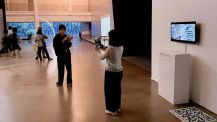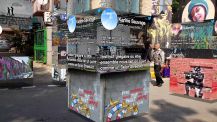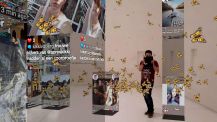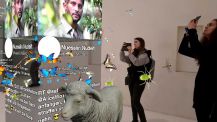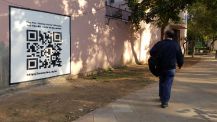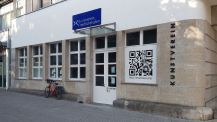Mobile App, AR Multiplayer Game
High towers rise into the sky, every place becomes a city.
With the Augmented Reality App 10.000 Moving Cities – Same but Different, AR one moves between the imaginary buildings via smartphone and tablet and participates in the digital communication streams and social movements of our time by means of inserted Social Media Posts. The buildings can be destroyed and rebuilt by the users. But beware! Everyone sees what the other is doing from different perspectives. The more buildings disappear, the more creatures appear.
10,000 Moving Cities – Same but Different, AR focuses on how places are constantly changing, language diversity, plant and animal species are diminishing, and buildings, shopping centres and cities are becoming more similar. Places are emerging that could be anywhere in the world with no real local identity. This process is accelerated by, for example, technological progress, fast transport and communication.
Stadtbibliothek, Stuttgart, Germany
Chandigarh, India
Application
The AR application allows multiple users to simultaneously experience an identical virtual city built from social media posts. Interactions in the virtual city, such as the destruction of building blocks, are also visible on all connected devices simultaneously. Posts on the bricks are incorporated in real time as they are sent out on Twitter within a 5km radius. Alternatively, hashtags can be pre-defined with the curator. ARCore (Google’s SDK for Android devices) and ARKit (Apple’s SDK for iOS devices) were used for the motion tracking of the augmented reality application. This makes it possible to detect the orientation and position of the device.
The application can take into account the constraints of the real space, such as the size dimensions or the presence of real obstacles, and define the space in which the virtual world is projected. (Figure below). In addition, it is possible to define several areas (Chunks) in a room and to set for each of these areas how small the minimum and maximum areas to be projected may be. The actual size, i.e. the number of building blocks and the size of each building block, is determined randomly. Once a configuration has been created in this way, the random seed parameter can also be used to change all the random parameters. This also ensures that the same random seed will always create the same city. This allows an optimised configuration of a projected city to be created and reused. This allows a host to initialise the previously configured city and make it available over the network. Clients on the same network can then connect to the host. The city is replicated and can be viewed and experienced equally on all connected devices.

Credits
Marc Lee in collaboration with the Intelligent Sensor-Actuator-Systems Laboratoy (ISAS) at the Karlsruhe Institute of Technology (KIT).
Install the App
https://marclee.io/en/ar
QR Codes in Public Spaces

